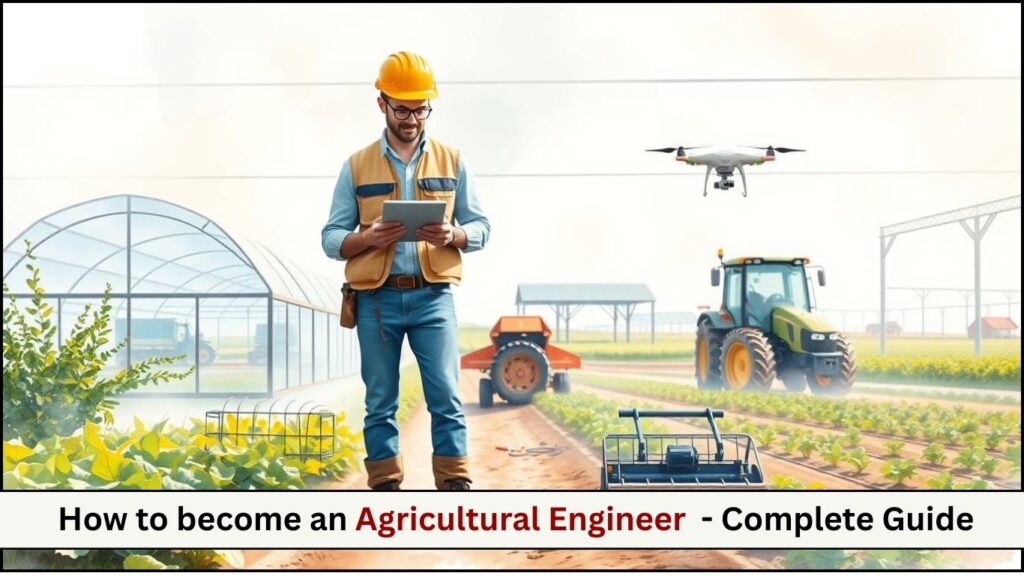
Introduction
Agricultural engineering is a vital field that combines engineering principles with agricultural sciences to improve farming efficiency, sustainability, and productivity. With the growing global demand for food and the need for sustainable farming practices, agricultural engineers play a crucial role in modern agriculture.
In this blog, we will explore:
- History of Agricultural Engineering
- Roles and Responsibilities
- Salary and Job Outlook
- Required Qualifications
- How to Get Started
- Future Scope and Trends
Whether you’re a student considering this career or a professional exploring opportunities, this guide will provide valuable insights.
History of Agricultural Engineering
Agricultural engineering has evolved significantly over centuries. Early civilizations used basic tools for farming, but the Industrial Revolution (18th-19th century) marked the beginning of mechanized agriculture.
Key Milestones:
- 1700s: Invention of the seed drill by Jethro Tull.
- 1800s: Development of steam-powered tractors and threshing machines.
- Early 1900s: Establishment of the first agricultural engineering programs in universities.
- Mid-1900s: Introduction of irrigation systems, hybrid seeds, and synthetic fertilizers.
- 21st Century: Precision farming, automation, and AI-driven agriculture.
Today, agricultural engineers integrate technology like drones, IoT, and robotics to enhance farming efficiency.
Roles and Responsibilities of an Agricultural Engineer
Agricultural engineers work on various aspects of farming, from machinery design to environmental conservation.
Primary Responsibilities:
- Designing Farm Equipment – Developing efficient machinery like tractors, harvesters, and irrigation systems.
- Soil and Water Management – Implementing sustainable irrigation and drainage systems.
- Food Processing Technology – Improving storage, handling, and processing techniques.
- Environmental Protection – Reducing pollution and promoting eco-friendly farming.
- Precision Agriculture – Using GPS, drones, and AI for optimized farming.
- Research & Development – Innovating new farming techniques and technologies.
Work Environments:
- Government agencies (USDA, FAO)
- Private agribusiness firms
- Research institutions
- NGOs and environmental organizations
Salary and Job Outlook for Agricultural Engineers
Agricultural engineering offers competitive salaries with strong growth potential.
Average Salaries (2024 Data):
| Country | Average Salary (Annual) |
|---|---|
| USA | $80,000 – $100,000 |
| UK | £35,000 – £50,000 |
| Canada | CAD 60,000 – CAD 85,000 |
| India | ₹4,00,000 – ₹8,00,000 |
| Australia | AUD 70,000 – AUD 100,000 |
Job Growth:
The Bureau of Labor Statistics (USA) predicts a 5% growth in agricultural engineering jobs by 2032, driven by the need for sustainable farming and food security.
Qualifications Required to Become an Agricultural Engineer
To enter this field, you need a mix of education and skills.
Educational Requirements:
- Bachelor’s Degree – In Agricultural Engineering, Mechanical Engineering, or related fields.
- Master’s Degree (Optional) – For specialized roles in research or management.
- Certifications – Licensure (PE – Professional Engineer) may be required in some countries.
Essential Skills:
✔ Mechanical & Civil Engineering Basics
✔ Knowledge of Agronomy & Soil Science
✔ Proficiency in CAD & GIS Software
✔ Problem-Solving & Analytical Skills
✔ Understanding of Sustainable Practices
How to Get Started in Agricultural Engineering
If you’re interested in this career, follow these steps:
Step 1: Pursue a Relevant Degree
- Enroll in a B.Tech/B.Sc in Agricultural Engineering or related discipline.
- Top institutions: IITs (India), UC Davis (USA), Wageningen University (Netherlands).
Step 2: Gain Practical Experience
- Internships with agribusiness firms (John Deere, Syngenta).
- Work on farm projects or research labs.
Step 3: Obtain Certifications (If Needed)
- Certified Agricultural Engineer (CAE)
- Professional Engineer (PE) License (USA)
Step 4: Build a Strong Portfolio
- Work on projects related to farm automation, irrigation, or sustainable farming.
- Publish research papers or attend agricultural tech conferences.
Step 5: Apply for Jobs
- Explore job portals like LinkedIn, AgCareers, and government agricultural departments.
Future Scope of Agricultural Engineering
The future of agricultural engineering is promising due to technological advancements and global food demands.
Emerging Trends:
- Precision Farming – AI, IoT, and drones for smart agriculture.
- Vertical & Hydroponic Farming – Urban farming solutions.
- Bioengineering – Genetically modified crops for higher yield.
- Renewable Energy in Farming – Solar-powered irrigation & biogas.
- Climate-Resilient Agriculture – Adapting to climate change challenges.
Top Companies Hiring Agricultural Engineers:
- John Deere
- AGCO Corporation
- Bayer CropScience
- Syngenta
- FAO & World Bank (for sustainable projects)
Conclusion
Agricultural engineering is a dynamic and rewarding career that bridges technology and farming. With increasing global food demands and sustainability challenges, skilled agricultural engineers are in high demand.
If you’re passionate about innovation, sustainability, and agriculture, this field offers excellent growth opportunities. Start by gaining the right education, hands-on experience, and staying updated with industry trends.
Are you considering a career in agricultural engineering? Share your thoughts in the comments!













Post Comment